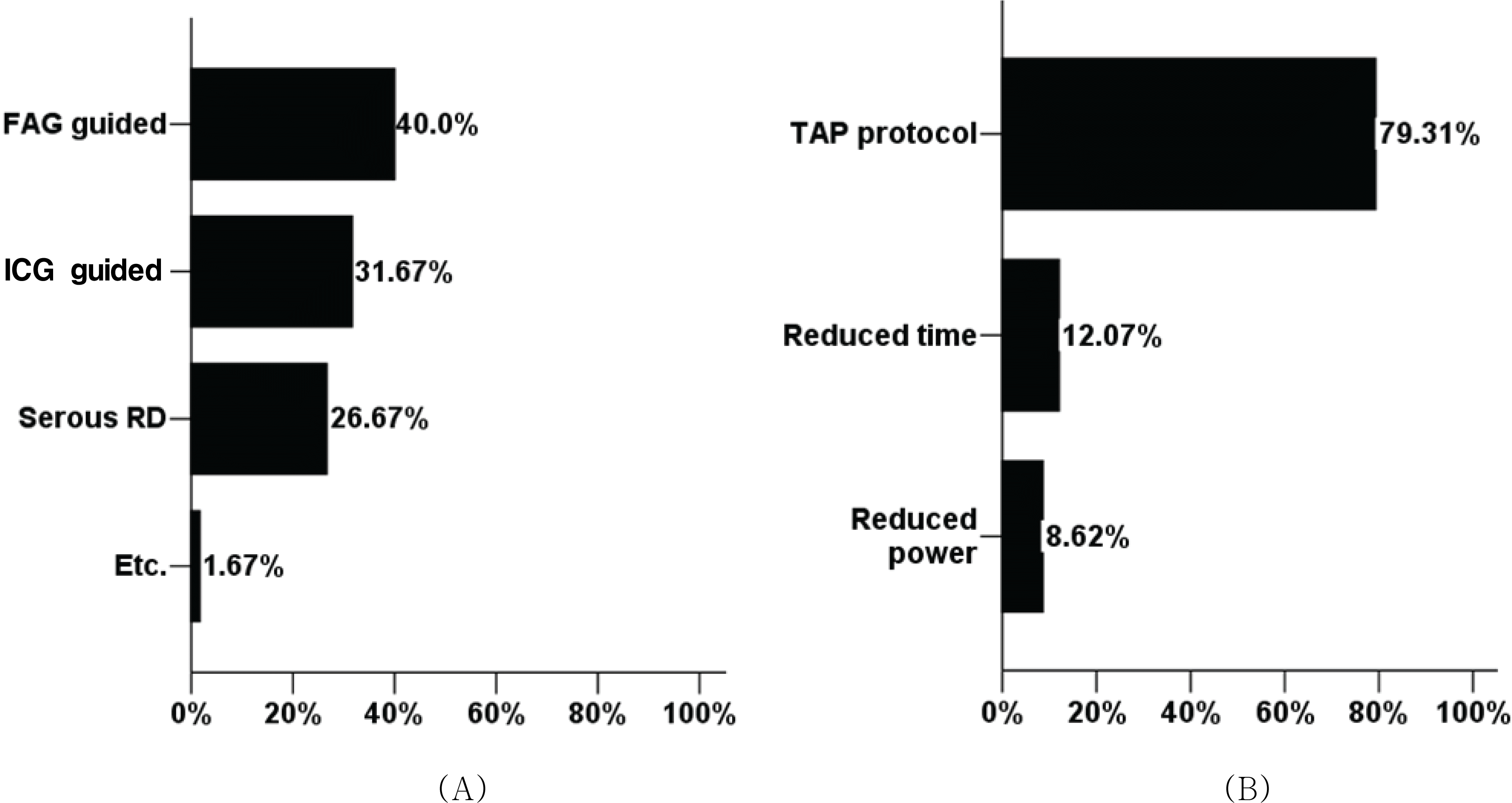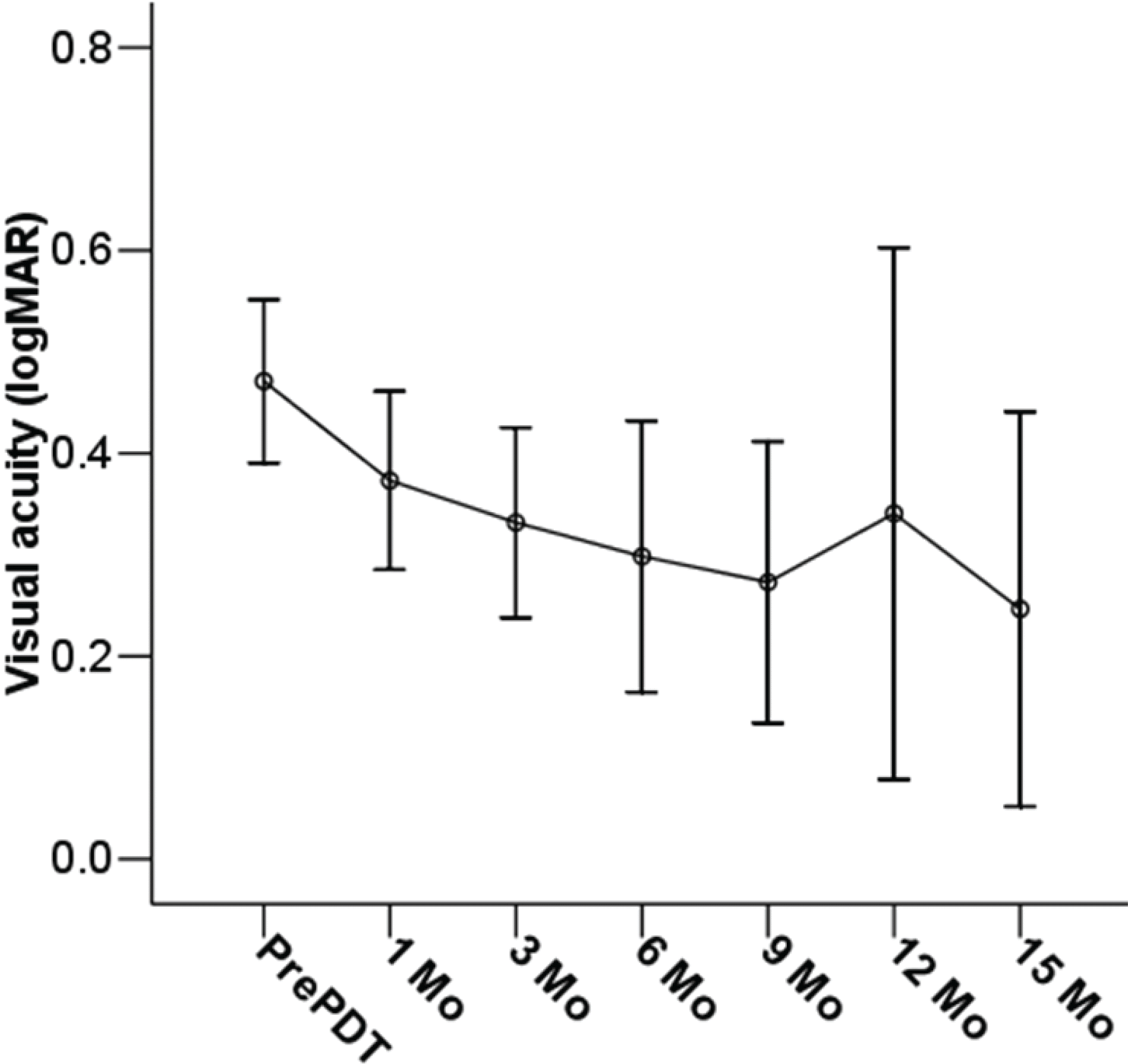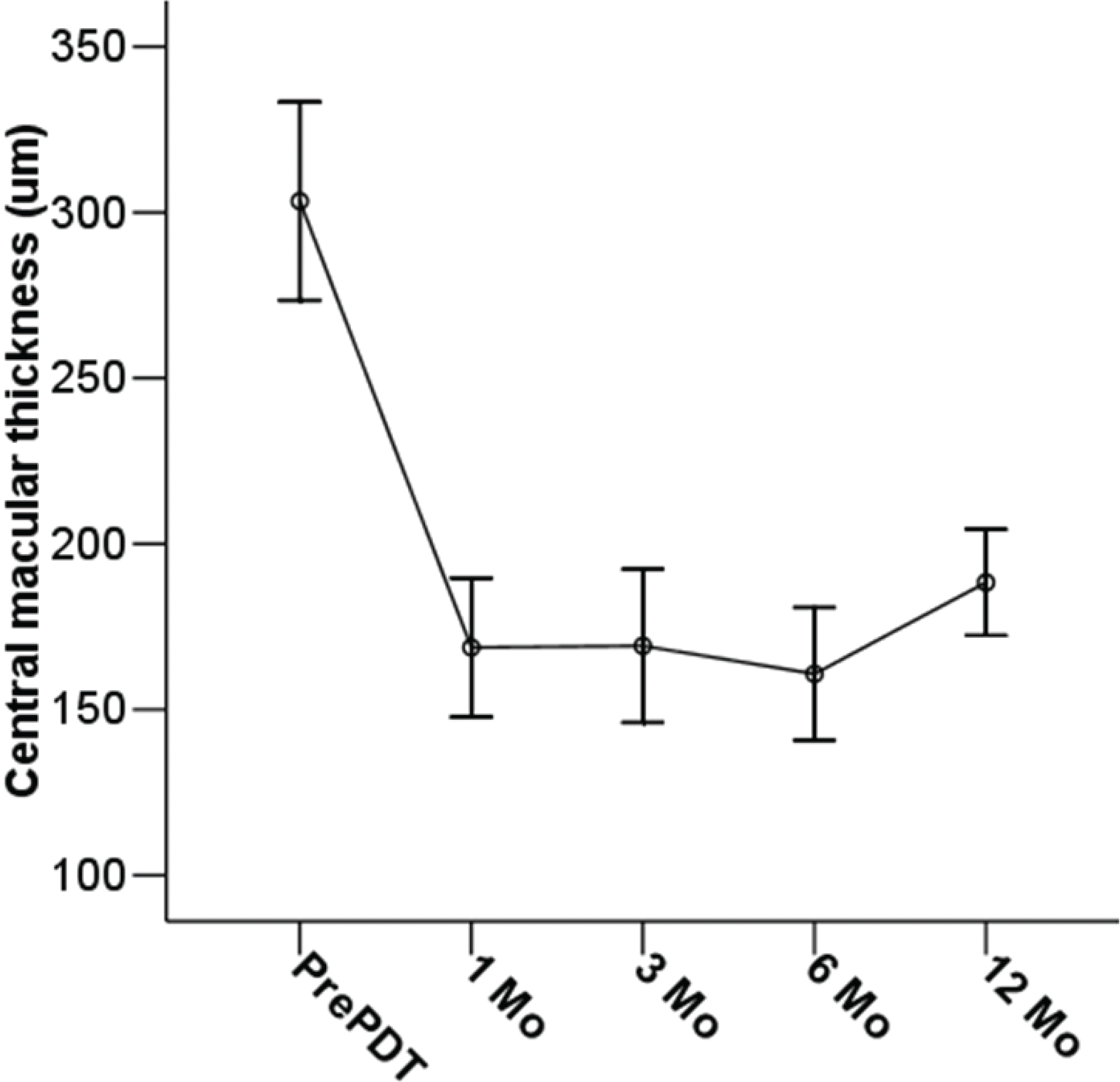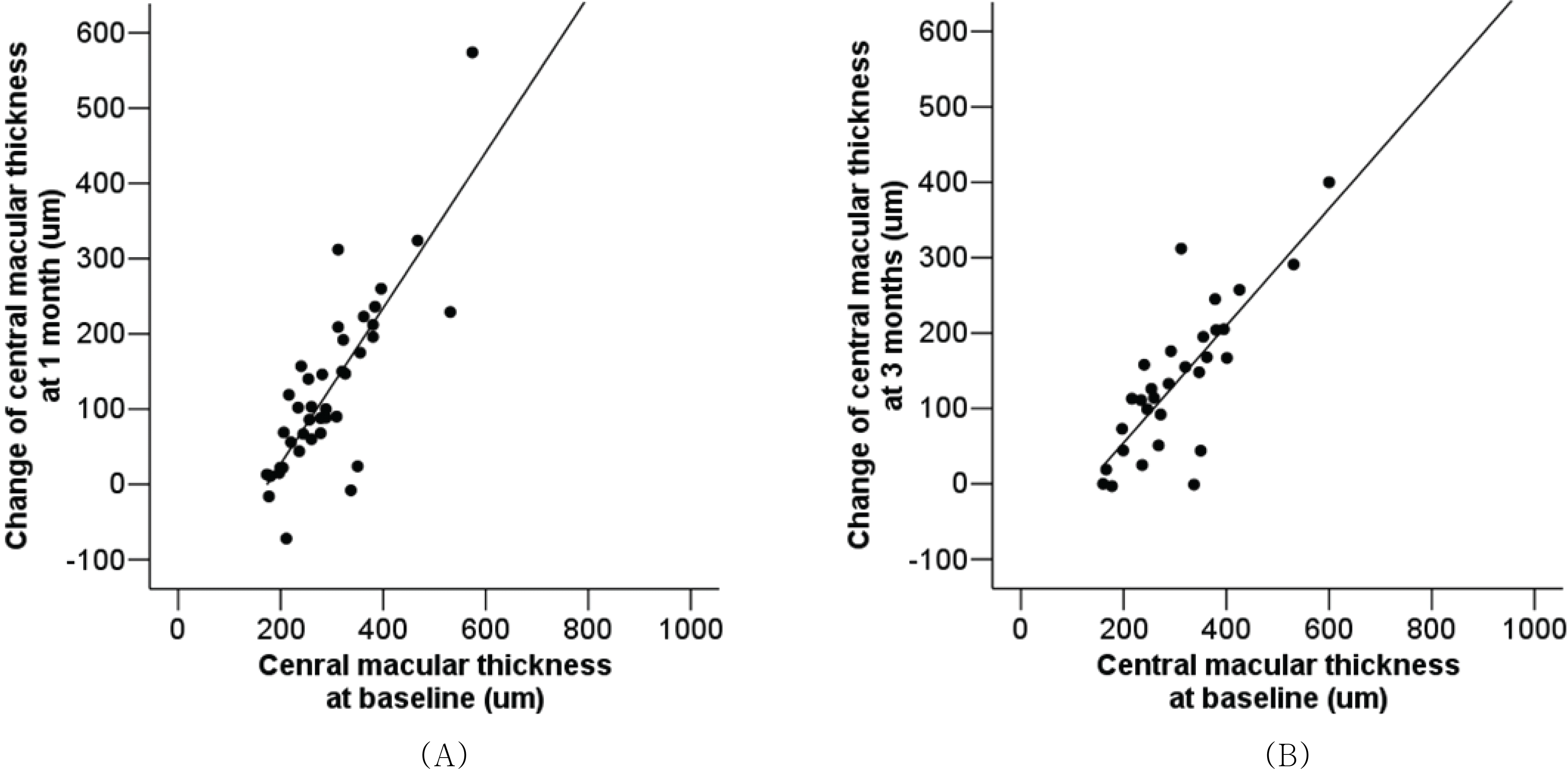Abstract
Purpose
To determine the effect of photodynamic therapy (PDT) on patients with chronic central serous chorioretinopahty (CSC).
Methods
This was a retrospective multicenter study. We collected demographic and ophthalmic data for patients with chronic CSC who were treated with PDT from 16 institutions in Korea. The best corrected visual acuity (BCVA), ophthalmoscopic finding and optical coherence tomography at baseline and follow-up visits were compared longitudinally.
Results
Sixty-five eyes of 65 patients were recruited. Males (51 patients, 78.5%) outnumbered females (14 patients, 21.5%). The mean age was 46.4±10.0 years of age (28∼69). By 1 month, mean BCVA improved from 0.47 to 0.37 (logarithm of the minimum angle of resolution) (P<0.01). This BCVA increased throughout 6 months. Subretinal fluid resolved partially or completely in 89.1% of the patients. Central macular thickness (CMT) decreased from 303.4 to 168.7 μ m. The amount of change in CMT after PDT was correlated to the female sex and prePDT CMT. At 3 months after PDT, the amount of change in BCVA was significantly related to that of change of CMT (p <0.05). Adverse events were reported in 4 cases, however, most were mild.
References
1. Gass JD. Pathogenesis of disciform detachment of the neuro- epithelium. II. Idiopathic central serous choroidopathy. Am J Ophthalmol. 1967; 63:587–615.
2. Jalkh AE, Jabbour N, Avila MP, et al. Retinal pigment epithelium decompensation. I. Clinical features and natural course. Ophthalmology. 1984; 91:1544–8.
3. Loo RH, Scott IU, Flynn HW Jr, et al. Factors associated with reduced visual acuity during long-term follow-up patients with idiopathic central serous chorioretinopathy. Retina. 2002; 22:19–24.
4. Leaver P, Williams C. Argon laser photocoagulation in the treatment of central serous retinopathy. Br J Ophthalmol. 1979; 63:674–7.

5. Robertson DM, Ilstrup D. Direct, indirect and sham laser photocoagulation in the management of central serous chorioretinopathy. Am J Ophthalmol. 1983; 95:457–66.

6. Jalk AE, Jabbour N, Avila M, et al. Retinal pigment epithelium decompensation. II. Laser treatment. Ophthalmology. 1984; 91:1549–53.
7. Kim HC, Kim HK. Choroidal neovascularization in patients with chronic central serous chorioretinopathy. J Korean Ophthalmol Soc. 2000; 41:684–90.
8. Lai TY, Chan WM, Li H, et al. Safety enhanced photodynamic therapy with half dose verteporfin for chronic central serous chorioretinopathy: a short term pilot study. Br J Ophthalmol. 2006; 90:869–74.

9. Cardillo Piccolino F, Eandi CM, Ventre L, et al. Photodynamic therapy for chronic central serous chorioretinopathy. Retina. 2003; 23:752–63.
10. TAP Study Group. Photodynamic therapy of subfoveal choroidal neovascularization in age-related macular degeneration with verteporfin. One-year results of 2 randomized clinical trials. TAP report 1. Arch Ophthalmol. 1999; 117:1329–45.
11. Wang MS, Sander B, Larsen M. Retinal atrophy in idiopathic central serous chorioretinopathy. Am J Ophthalmol. 2002; 133:787–93.
12. Tittl MK, Spaide RF, Wong D, et al. Systemic and ocular findings in central serous chorioretinopathy. Am J Ophthalmol. 1999; 128:63–8.
Figure 1.
Distribution of methods (A) used to determine the area for photodynamic treatment and protocols (B).

Figure 2.
Change of visual acuity after photodynamic treatment. By 1 month, mean visual acuity was improved from 0.47 to 0.37 logarithm of the minimum angle of resolution (p <0.01, paired t-test). This visual improvement increased until 6 months after treatment.

Figure 3.
Change of the mean central macular thickness after photodynamic treatment. By 1 month, the mean central macular thickness decreased from 303.4 to 168.7 μm (p<0.001, paired t-test). This macular thickness was maintained after then.

Figure 4.
Comparison of the central macular thickness in baseline and 1 month (A) or 3 months (B) after photodynamic treatment.

Table 1.
Factors related to the change of vision at 1 month and 3 months after photodynamic treatment (linear regression analysis)
| At 1 month | At 3 months | |||||||
|---|---|---|---|---|---|---|---|---|
| Univariate | Multivariate (R2=0.278) | Univariate | Multivariate (R2=0.455) | |||||
| B | p-value | B | p-value | B | p-value | B | p-value | |
| Age | 0.005 | 0.021 | 0.004 | 0.096 | 0.001 | 0.788 | ||
| Female | 0.043* | 0.078 | 0.158 | 0.177* | 0.497 | |||
| Duration | 0.176 | 0.243 | −0.001 | 0.045 | −0.134 | 0.062 | ||
| Leakage pattern | 0.330† | 0.638† | ||||||
| PED | 0.867* | 0.814* | ||||||
| Decision | 0.810† | 0.252† | ||||||
| Amount | 0.085† | 0.036 | 0.102 | 0.350† | ||||
| CMT‡ baseline | <0.001 | 0.063 | 0.000 | 0.116 | <0.001 | 0.072 | −0.001 | 0.113 |
| CMT change | <0.001 | 0.489 | 0.001 | 0.011 | 0.001 | 0.042 | ||
| Vision pre | 0.113 | 0.089 | 0.090 | 0.184 | 0.097 | 0.267 | ||
Table 2.
Factors related to the change of central macular thickness at 1 month and 3 months after photodynamic treatment (linear regression analysis)
| At 1 month | At 3 months | |||||||
|---|---|---|---|---|---|---|---|---|
| Univariate | Multivariate (R2=0.813) | Univariate | Multivariate (R2=0.789) | |||||
| B | p-value | B | p-value | B | p-value | B | p-value | |
| Age | −0.931 | 0.667 | 3.371 | 0.078 | 0.324 | 0.816 | ||
| Female | 0.014* | 0.011 | 0.009* | 0.020 | ||||
| Duration | 1.156 | 0.254 | −33.382 | 0.348 | ||||
| Leakage pattern | 0.047† | 0.799 | 0.977 | 0.138† | ||||
| PED | 0.292* | 0.048* | 0.807 | |||||
| Decision | 0.172† | 0.428† | ||||||
| Amount | 0.914† | − | ||||||
| CMT‡ baseline | 1.035 | <0.001 | 0.984 | <0.001 | 0.776 | <0.001 | 0.615 | <0.001 |
| Vision baseline | 55.798 | 0.408 | −63.532 | 0.344 | ||||
| Vision change | 96.248 | 0.489 | 262.547 | 0.011 | 127.603 | 0.032 | ||




 PDF
PDF ePub
ePub Citation
Citation Print
Print


 XML Download
XML Download